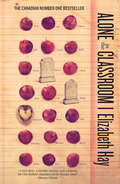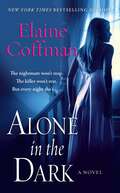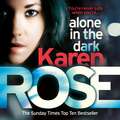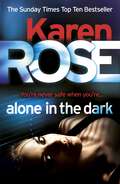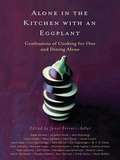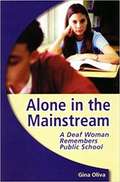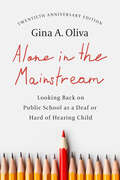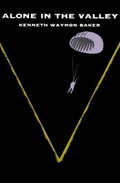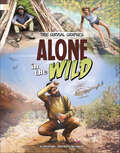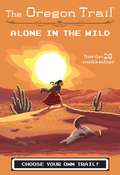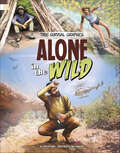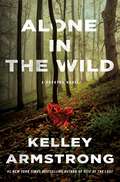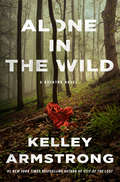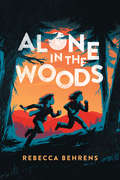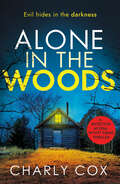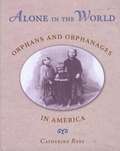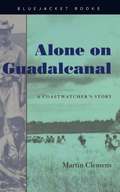- Table View
- List View
Alone in the Classroom
by Elizabeth HayIn a small prairie school in 1929, Connie Flood helps a backward student, Michael Graves, learn how to read. Observing them and darkening their lives is the principal, Parley Burns, whose strange behaviour culminates in an attack so disturbing its repercussions continue to the present day. Connie's niece, Anne, tells the story. Impelled by curiosity about her dynamic, adventurous aunt and her more conventional mother, she revisits Connie's past and her mother's broken childhood. In the process she unravels the enigma of Parley Burns and the mysterious, and unrelated, deaths of two young girls.
Alone in the Crowd (Sweet Valley High #28)
by Kate WilliamSecret song... Lynne Henry is tall, awkward, and painfully shy. The one bright spot in her life is her songwriting. In her room, playing her guitar, Lynne forgets how lonely she is and becomes someone special. When The Droids, Sweet Valley High's most popular rock band, announce a songwriting contest, Lynne enters it. But she is so insecure about her talent that she submits her song anonymously. As soon as they hear Lynne's song, The Droids know they've got a winner. Guy Chesney, the attractive lead guitarist for the band, vows to find the songwriter, no matter how long it takes. Only Elizabeth Wakefield knows Lynne's secret. Can she persuade Lynne to come out into the open and share her talent, or is Lynne destined to remain unnoticed?
Alone in the Dark
by CoffmanWhen her dying father confesses that he is not her biological father -- and that he has a twin -- Washington, D.C., morning news anchor Ellery O'Brien is desperate for answers. Plagued by a recurring nightmare in which a blood-covered woman who has been stabbed repeatedly by a killer, staggers down the staircase of a beautiful old house, Ellery travels to her late mother's hometown -- Agarita Springs, Texas -- not realizing until she arrives that she has rented the very house she sees in her dreams. No one in town wants to dig up the past, but rancher Clint Littleton begins to help Ellery and white-hot attraction sparks between them. The nightmares, however, persist. And each time, before Ellery awakes, she sees an increasingly terrifying image: just a little more of the killer's face. . . New York Times bestselling author Elaine Coffman switches gears with pulse-pounding results in her first novel of heart-stopping romantic suspense.
Alone in the Dark
by Karen RoseThe New York Times bestselling author of Closer Than You Think returns with a breathtaking new novel of suspense in the Cincinnati series--one that crosses the line between danger and desire, and justice and revenge.<P><P> Homicide Detective Scarlett Bishop has seen enough bad guys slip through the cracks and innocent victims go unavenged to know that good doesn't always prevail. So far she's been able to lock away her rage and her vigilante fantasies. That lock is about to break. Former Army Ranger Marcus O'Bannion is a fierce champion of victims' rights. His secret past gives him good reason. He believes he's seen the depths of human depravity, but then his investigation into the murder of a young girl who once asked for his help lures him and Scarlett down a dark, dark road--and straight into the crosshairs of a dangerous, powerful underground ring that deals in human trafficking. To stop them, Scarlett and Marcus have to be just as cunning and just as ruthless. But first they have to make it out alive.From the Paperback edition.
Alone in the Dark (Cavanaugh Justice #8)
by Marie FerrarellaHeck, the reclusive officer hardly spoke to anyone otherthan his faithful K-9 companion. So what harm could comefrom Patience Cavanaugh letting the haunted rebel protecther from a dangerous stalker? She might be a veterinarian,but Patience had enough cop sense from the rest of herfamily to know that her life was on the line and Brady Coltranejust might be the one to save it. So despite the fact thatone look at her brooding bodyguard in blue made her hearttrip, wasn't she safer in Brady's embrace than standing thereall alone?
Alone in the Dark (Cincinnati Series #2)
by Karen RoseIn ALONE IN THE DARK, Karen Rose - the Sunday Times bestselling author of CLOSER THAN YOU THINK - returns with a breath-taking new novel in the Cincinnati series - would you cross the line between danger and desire, justice and revenge? A desperate hunt to find a young girl's killer is about to turn deadly...Former Army Ranger Marcus O'Bannion and homicide cop Scarlett Bishop have met only briefly but when Scarlett receives a phone call in the middle of the night, she immediately recognises the hauntingly smooth voice asking her to meet him in one of Cincinnati's roughest areas. On arriving, Scarlett finds the body of a seventeen-year-old Asian girl and Marcus injured. A fierce champion of victims' rights, Marcus claims the young woman was working for an affluent local family and the last time he saw her she was terrified, abused, and clearly in need of help. Having agreed to meet her, both Marcus and the young woman were targeted for death.As they investigate, Scarlett and Marcus are pulled into the dangerous world of human trafficking where they soon realise they are going to have to become as ruthless as those they are hunting. Because if they don't, how many other girls may end up alone in the dark?(P)2015 Headline Digital
Alone in the Dark (Cincinnati Series #2)
by Karen RoseIn ALONE IN THE DARK, Karen Rose - the Sunday Times bestselling author of CLOSER THAN YOU THINK - returns with a breath-taking new novel in the Cincinnati series - would you cross the line between danger and desire, justice and revenge? A desperate hunt to find a young girl's killer is about to turn deadly...Former Army Ranger Marcus O'Bannion and homicide cop Scarlett Bishop have met only briefly but when Scarlett receives a phone call in the middle of the night, she immediately recognises the hauntingly smooth voice asking her to meet him in one of Cincinnati's roughest areas. On arriving, Scarlett finds the body of a seventeen-year-old Asian girl and Marcus injured. A fierce champion of victims' rights, Marcus claims the young woman was working for an affluent local family and the last time he saw her she was terrified, abused, and clearly in need of help. Having agreed to meet her, both Marcus and the young woman were targeted for death.As they investigate, Scarlett and Marcus are pulled into the dangerous world of human trafficking where they soon realise they are going to have to become as ruthless as those they are hunting. Because if they don't, how many other girls may end up alone in the dark?
Alone in the Jungle (Fountas & Pinnell LLI Gold #Level Q)
by Alice Cary<p>Lost in the Rainforest <p>After a plane crash, seventeen-year-old Juliane Koepcke found herself alone in the middle of the South American jungle. She had nothing but the dress she was wearing, one shoe, and a few pieces of candy. Could she possibly survive? <p> <p>Text Elements: <p> <p>Genre: Narrative Nonfiction <p>Text Structures: Main: Chronological Sequence Embedded: Description, Problem/Solution <p>Text Features: table of contents, headings, photos, captions, pronunciation guide, sidebars, map, labels</p>
Alone in the Kitchen with an Eggplant
by Jenni Ferrari-AdlerIn this delightful and much buzzed-about essay collection, 26 food writers like Nora Ephron, Laurie Colwin, Jami Attenberg, Ann Patchett, and M. F. K. Fisher invite readers into their kitchens to reflect on the secret meals and recipes for one person that they relish when no one else is looking. Part solace, part celebration, part handbook, Alone in the Kitchen with an Eggplant offers a wealth of company, inspiration, and humor--and finally, solo recipes in these essays about food that require no division or subtraction, for readers of Gabrielle Hamilton's Blood, Bones & Butter and Tamar Adler's The Everlasting Meal. Featuring essays by: Steve Almond, Jonathan Ames, Jami Attenberg, Laura Calder, Mary Cantwell, Dan Chaon, Laurie Colwin, Laura Dave, Courtney Eldridge, Nora Ephron, Erin Ergenbright, M. F. K. Fisher, Colin Harrison, Marcella Hazan, Amanda Hesser, Holly Hughes, Jeremy Jackson, Rosa Jurjevics, Ben Karlin, Rattawut Lapcharoensap, Beverly Lowry, Haruki Murakami, Phoebe Nobles, Ann Patchett, Anneli Rufus and Paula Wolfert.
Alone in the Mainstream: A Deaf Woman Remembers Public School (Gallaudet New Deaf Lives #1)
by Gina A. OlivaWhen Gina Oliva first went to school in 1955, she didn’t know that she was “different.” If the kindergarten teacher played a tune on the piano to signal the next exercise, Oliva didn’t react because she couldn’t hear the music. So began her journey as a “solitary,” her term for being the only deaf child in the entire school. Gina felt alone because she couldn’t communicate easily with her classmates, but also because none of them had a hearing loss like hers. It wasn’t until years later at Gallaudet University that she discovered that she wasn’t alone and that her experience was common among mainstreamed deaf students. Alone in the Mainstream recounts Oliva’s story, as well as those of many other solitaries. In writing this important book, Oliva combined her personal experiences with responses from the Solitary Mainstream Project, a survey that she conducted of deaf and hard of hearing adults who attended public school. Oliva matched her findings with current research on deaf students in public schools and confirmed that hearing teachers are ill-prepared to teach deaf pupils, they don’t know much about hearing loss, and they frequently underestimate deaf children. The collected memories in Alone in the Mainstream add emotional weight to the conviction that students need to be able to communicate freely, and they also need peers to know they are not alone.
Alone in the Mainstream: Looking Back on Public School as a Deaf or Hard of Hearing Child (Deaf Lives #14)
by Gina A. OlivaIn 1975, federal legislation initiated drastic changes in the education of deaf and hard of hearing children. Public Law 94-142, later known as IDEA, proposed to provide the “Least Restrictive Environment” for all such children. In the years since, advocates for deaf and hard of hearing children have raised the alarm that mainstream educational settings can cause language and social deprivation for these children. In Alone in the Mainstream, author Gina A. Oliva documents her experience as a “solitaire,” the only deaf or hard of hearing student in her school. Oliva felt alone because she couldn’t communicate easily with her classmates and because she had no peers who shared a similar experience. As an adult, when she began her career at Gallaudet University, she realized that she wasn’t alone and that her experience was widely shared with other mainstreamed students. She decided to write about this commonality and invited other solitaires to reflect on their own experiences in emails and essays. Collective themes of isolation, low expectations, and low self-esteem emerged. Alone in the Mainstream blends Oliva’s personal narrative with the reflections of sixty other solitaires and makes the case that deaf and hard of hearing children need each other. This twentieth anniversary edition is a reminder that little has changed for deaf and hard of hearing students in public school settings. Oliva brings this new edition up to date with observations, resources, and discussion questions that accompany her appeal for all deaf and hard of hearing children and their families to have access to sign language, to develop a deaf identity, and to be part of a deaf community.
Alone in the Mirror: Twins in Therapy
by Barbara KleinAlone in the Mirror: Twins in Therapy chronicles the triumphs and struggles of twins as they separate from one another and find their individuality in a world of non twins. The text is grounded in issues of attachment and intimacy, and is highlighted by Dr. Barbara Klein’s scholarly research, clinical experiences with twins in therapy, and her own identity struggles as a twin, all of which allow her to present insights into the rare, complicated, and misunderstood twin identity. She presents psychologically-focused real life histories, which demonstrate how childhood experiences shape the twin attachment and individual development, and she describes implications for twins in therapy, their therapists, and parents of twins. Unique to this book are effective therapeutic practices, developed specifically for twins, and designed to raise the consciousness of parents as well. Readers will find these practices and the insights within invaluable, whether they use them to communicate with twin patients, family members, or if they are part of a twinship themselves.
Alone in the Valley
by Kenneth Waymon Baker&“This first novel by a disabled Vietnam veteran compassionately examines a year in the life of a combat infantryman during that conflict&” (Publishers Weekly). Alone in the Valley tells the story of nineteen-year-old Daniel Perdue and his year as a grunt, pursuing an elusive enemy through the steamy jungles of the Central Vietnamese Highlands. From the moment the boy solider touches down until he is airborne on his way home again, author Kenneth Waymon Baker makes sure the reader hears every sound, sees every sight, feels every emotion as his young hero faces the rigors of war. Daniel is changed forever, a man who will return with the instincts of a warrior. If you only read one book about Vietnam, make it Alone in the Valley. It will leave you touched and changed. &“A well-written and unassuming debut novel whose very artlessness is its principle virtue. Though his voice is unique, Baker tells it exactly as it was.&” —Kirkus Reviews
Alone in the Wild
by Jarred LujánA cyclist wanders away from his bike in Australia’s Great Sandy Desert. A fisherman loses his way in the Sierra Nevada mountains. A camper falls off a cliff in Mount Hood National Forest. These remarkable true tales could have ended in tragedy—but they didn’t! What happened to three people who found themselves stuck in the wilderness? And how did they survive to tell their tales? Young readers will find out in this easy-to-read hi-lo graphic novel that will keep them on the edge of their seats!
Alone in the Wild (The Oregon Trail)
by Jesse WileyIn this exciting choose-your-own-trail stand-alone experience featuring 8-bit art, it's 1849 and you are at the halfway point on your journey west on the Oregon Trail. When a powerful storm separates you from your family, you must use all of your smarts to survive on your own. Along the way, you meet a twelve-year-old girl from the Shoshone Nation, who has the grit and smarts to help you both make it to Oregon Territory. Which path will get you safely across the country and reunited with your family? With twenty-two possible endings, choose wrong and you'll never live out your dreams. Choose right and blaze a trail that gets you to Oregon City! Twitter: @oregontrail Facebook: facebook.com/oregontrail/
Alone in the Wild (True Survival Graphics)
by Jarred LujánA cyclist wanders away from his bike in Australia&’s Great Sandy Desert. A fisherman loses his way in the Sierra Nevada mountains. A camper falls off a cliff in Mount Hood National Forest. These remarkable true tales could have ended in tragedy—but they didn&’t! What happened to three people who found themselves stuck in the wilderness? And how did they survive to tell their tales? Young readers will find out in this easy-to-read hi-lo graphic novel that will keep them on the edge of their seats!
Alone in the Wild (True Survival Graphics)
by Jarred LujánA cyclist wanders away from his bike in Australia&’s Great Sandy Desert. A fisherman loses his way in the Sierra Nevada mountains. A camper falls off a cliff in Mount Hood National Forest. These remarkable true tales could have ended in tragedy—but they didn&’t! What happened to three people who found themselves stuck in the wilderness? And how did they survive to tell their tales? Young readers will find out in this easy-to-read hi-lo graphic novel that will keep them on the edge of their seats!
Alone in the Wild: A Rockton Novel (Casey Duncan Novels #5)
by Kelley ArmstrongIn #1 New York Times bestseller Kelley Armstrong's latest thriller, the hidden town of Rockton is about to face a challenge none of them saw coming: a baby.Every season in Rockton seems to bring a new challenge. At least that's what Detective Casey Duncan has felt since she decided to call this place home. Between all the secretive residents, the sometimes-hostile settlers outside, and the surrounding wilderness, there's always something to worry about. While on a much needed camping vacation with her boyfriend, Sheriff Eric Dalton, Casey hears a baby crying in the woods. The sound leads them to a tragic scene: a woman buried under the snow, murdered, a baby still alive in her arms. A town that doesn’t let anyone in under the age of eighteen, Rockton must take care of its youngest resident yet while solving another murder and finding out where the baby came from - and whether she's better off where she is. #1 New York Times bestselling author Kelley Armstrong again delivers an engaging, tense thriller set in perhaps the most interesting town in all of contemporary crime fiction.
Alone in the Wild: A Rockton Thriller (City of the Lost 5) (City of the Lost #5)
by Kelley ArmstrongIn #1 New York Times bestseller Kelley Armstrong's latest thriller, the hidden town of Rockton is about to face a challenge none of them saw coming: a baby.Every season in Rockton seems to bring a new challenge. At least that's what Detective Casey Duncan has felt since she decided to call this place home. Between all the secretive residents, the sometimes-hostile settlers outside, and the surrounding wilderness, there's always something to worry about.While on a much needed camping vacation with her boyfriend, Sheriff Eric Dalton, Casey hears a baby crying in the woods. The sound leads them to a tragic scene: a woman buried under the snow, murdered, a baby still alive in her arms.A town that doesn't let anyone in under the age of eighteen, Rockton must take care of its youngest resident yet while solving another murder and finding out where the baby came from--and whether she's better off where she is.#1 New York Times bestselling author Kelley Armstrong again delivers an engaging, tense thriller set in perhaps the most interesting town in all of contemporary crime fiction.
Alone in the Woods
by Rebecca BehrensFrom the author of The Disaster Days comes a thrilling survival story, and lost in the woods children's book, about two former best friends who must work together to stay alive after getting lost in a remote national forest.Jocelyn and Alex have always been best friends…until they aren't. Jocelyn's not sure what happened, but she hopes the annual joint-family vacation in the isolated north woods will be the perfect spot to rekindle their friendship.But Alex still isn't herself when they get to the cabin. And Jocelyn reaches a breaking point during a rafting trip that goes horribly wrong. When the girls' tube tears it leaves them stranded and alone. And before they know it, the two are hopelessly lost.Wearing swimsuits and water shoes and with only the contents of their wet backpack, the girls face threats from the elements. And as they spend days and nights lost in the wilderness, they'll have to overcome their fractured friendship to make it out of the woods alive.Praise for The Disaster Days:"A realistic, engrossing survival story that's perfect for aspiring babysitters and fans of John Macfarlane's Stormstruck!, Sherry Shahan's Ice Island, or Wesley King's A World Below."—School Library Journal"The strength of this steadily paced novel that stretches over four days of a scary disaster scenario is that Hannah doesn't figure everything out; she stumbles, doubts, and struggles throughout it all."—The Bulletin of the Center for Children's Books"Fans of survival thrillers in the vein of Gary Paulsen's Hatchet will enjoy this tense, honest tale of bravery...an excellent (and refreshingly not didactic) teaching tool on natural-disaster preparedness."—Booklist"The relentless progression of a variety of disaster scenarios will keep readers turning pages...equally suspenseful and informative."—School Library Connection"Behrens uses immersive details and situations effectively viewed from Hannah's perspective to create a suspenseful, vivid story filled with lessons about responsibility and overcoming adversity."—Publishers WeeklyAlone in the Woods is a perfect…gift for preteen survival story fanssummer reading tween book for girls 11-14book for middle school girls
Alone in the Woods: A completely gripping crime thriller that will have you on the edge of your seat (Detective Alyssa Wyatt)
by Charly Cox‘Make sure you have nothing else to do when starting this book. You will NOT be able to put it down!!' Reader ReviewThe parents are dead. The girls are hiding. The killer is still inside the house.Gabriel Kensington and his wife Lydia have been brutally slain in their luxurious home in New Mexico. A frantic, whispered phone call from their teenage daughter Addis, and her best friend Emerson, quickly alerts the authorities to the killings.But when detective Alyssa Wyatt and the squad appear at the house, the unthinkable has happened. The girls are nowhere to be found… and neither is the killer.In a race against time, it’s up to Alyssa Wyatt and her partner Cord to find the missing girls – and discover just why the Kensingtons have been targeted.Because for Addis and Emerson, every minute passing could be the difference between survival – or an unthinkable death.The addictive, absolutely nail-biting new Alyssa Wyatt detective novel will have fans of Kendra Elliot, Melinda Leigh, or Angela Marsons on the edge of their seat.Readers are loving Alone in the Woods:‘Be ready to read well past your bedtime!A seriously addictive series and if you haven’t discovered it for yourself yet, then now is the time.’ Reader Reviewer‘Charly Cox is fast becoming one of my favourite crime fiction writers!Gripping, with likeable characters and great researched and plotted story lines.’ Reader Reviewer‘Charly Cox tells the story in such a way that you can see it like a movie in your mind…Love this series!!’ ????? Reader Reviewer‘Kept me guessing until the end, read it one sitting as couldn’t leave it down’ ????? Reader Reviewer‘I love these books!!! Can’t get enough. Great suspense and good twists…Highly recommended’ ????? Reader Reviewer
Alone in the Woods: Cheryl Strayed, My Daughter, and Me
by Micah PerksWhat do you do when fate hands you a wild daughter? As Micah recounts her struggles to raise a brave daughter and to keep her safe at the same time, she also tells the story of her own sometimes humorous, sometimes harrowing two-week solo adventure in the Adirondack Mountains as a teenager. Micah Perks’ candid short memoir takes an insightful look at women and the wild, the wildness she experienced as a child on a commune in the Adirondack wilderness, the ways women and wildness are depicted in movies and books like Cheryl Strayed’s best-selling memoir Wild, and the wilderness she discovers inside her own daughter.
Alone in the World (Orphans And Orphanages In America)
by Catherine ReefWho hasn't wondered what it would be like to grow up in an orphanage? What was the food like? Where did the children sleep? Were the caregivers kind or cruel? How did one end up in an orphanage in the first place?
Alone on Guadalcanal
by Martin W. ClemensThis remarkable memoir tells the compelling story of the near-mythic British district officer who helped shape the first great Allied counteroffensive. Scottish-born and Cambridge-educated, Martin Clemens managed to survive months behind Japanese lines in one of the most unfriendly climates and terrains in the world. After countless partisan and spy missions, in 1942 he emerged from the jungle and integrated his Melanesian commando force into the heart of the 1st Marine Division's operations, earning the unfettered admiration of such legendary Marine officers as Vandegrift, Thomas, Twining, Edson, and Pate. The book is based on a journal Clemens kept during the war and might well be the last critical source of analysis of the Solomon's campaign. His eyewitness accounts of harrowing long-distance patrols and life on the run from shadowy Japanese intelligence operatives and treacherous islanders are unmatched in the literature of the Pacific War. First published in 1998, the story is essential and enjoyable reading.
